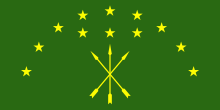
Back Къэбэртаехэр ADY Cabardos AN قبرديون Arabic Кабардиял AV Kabardalılar Azerbaijani Ҡабарҙылар Bashkir Kabardins Catalan ГӀебартой CE Kabardinere Danish Kabardiner German
Къэбэрдэй Адыгэ | |
|---|---|
 Flag of Kabardia | |
 | |
| Total population | |
| ~1,628,500 Kabardian dialect speakers[1][2] | |
| Regions with significant populations | |
| More than 1,000,000[3] | |
| 523,404 (2021 census)[4] | |
| | 502,615 |
| | 13,496 |
| Languages | |
| Kabardian, Russian, Turkish | |
| Religion | |
| Predominantly Sunni Islam[5][6] Minority Eastern Orthodox Church[7] and Catholic Church[8][9] | |
| Related ethnic groups | |
| Other Adyghe tribes, Abkhaz, Abaza | |
| Part of a series on the |
| Circassians Адыгэхэр |
|---|
 List of notable Circassians Circassian genocide |
| Circassian diaspora |
| Circassian tribes |
|
Surviving Destroyed or barely existing |
| Religion |
|
Religion in Circassia |
| Languages and dialects |
|
| History |
|
Show |
| Culture |



The Kabardians (Kabardian: Къэбэрдей адыгэхэр; Adyghe: Къэбэртай адыгэхэр; Russian: Кабарди́нцы) or Kabardinians are one of the twelve major Circassian tribes, representing one of the twelve stars on the green-and-gold Circassian flag.[10] They are also commonly known by the plural terms Kabardin, Kebertei, or Kabarday. Along with the Besleney tribe, they speak a distinctive dialect of Circassian. Historically the Kabardians lived in Kabardia, a region of the north Caucasus. In modern times the Kabardians live mostly in the Russian republic of Kabardino-Balkaria, which partly corresponds to the historic region.
Despite the Soviet administrative divisions that placed Circassians under four different designations and political units, namely Adygeans (Circassians in Adygea), Cherkessians (Circassians in Karachay-Cherkessia), Kabardians (Circassians in Kabardino-Balkaria), and Shapsugs (Circassians in Krasnodar Krai), all four groups are essentially the same people (Circassians). Furthermore, Cherkessians are mostly of the Kabardian and Besleney tribes.
- ^ "Kabardian: A Language of the Russian Federation". Etnologue.com. Ethnologue: Languages of the World. 2005. Archived from the original on 26 January 2017. Retrieved 5 December 2016.
- ^ Skutsch, Carl (2013). Encyclopedia of the World's Minorities. Routledge. p. 675. ISBN 978-1-135-19388-1.
- ^ "'Biz' Erozyona Uğratıldı". Jineps. March 2012. Archived from the original on 5 March 2017. Retrieved 5 December 2016.
- ^ "Национальный состав населения". Federal State Statistics Service. Retrieved 30 December 2022.
- ^ Svetlana Lyagusheva (2005). "Islam and the Traditional Moral Code of Adyghes". Iran and the Caucasus. 9 (1): 29–35. doi:10.1163/1573384054068123. JSTOR 4030903.
- ^ James Stuart Olson, ed. (1994). An Ethnohistorical dictionary of the Russian and Soviet empires. Greenwood. p. 329. ISBN 978-0-313-27497-8. Retrieved 15 October 2011.
- ^ James Stuart Olson, ed. (1994). An Ethnohistorical dictionary of the Russian and Soviet empires. Greenwood. p. 329. ISBN 978-0-313-27497-8. Retrieved 15 October 2011.
- ^ Arena – Atlas of Religions and Nationalities in Russia. Sreda.org
- ^ 2012 Survey Maps. "Ogonek", № 34 (5243), 27/08/2012. Retrieved 24-09-2012.
- ^ "Circassians". Adiga-home.net. 2010. Archived from the original on 20 August 2014. Retrieved 17 May 2016.
The 12 Circassian tribes: Abadzeh Besleney Bzhedug Yegeruqay Zhaney Kabarday Mamheg Natuhay Temirgoy Ubyh Shapsug Hatukay. The twelve stars on the Adyghe Flag also refers to the twelve tribes.
{{cite web}}: CS1 maint: unfit URL (link)